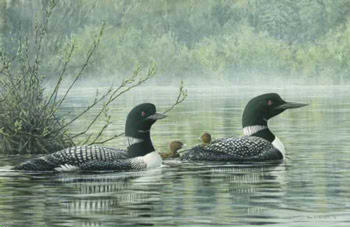Please Help Pets by Donating One Dollar
Common, Yellow-billed, Red-throated & Artic Loons
Loons are large size birds with a specialty for swimming and diving.
Loons have heavy, straight, sharp-edged bills; long bodies; short,
slender, pointed wings; and short, stiff tails. Their legs are short,
and the three front toes are webbed. Loons cannot walk on land
because their legs are placed far back on their bodies
Loons have a loud yodel like call, however they are silent in winter.
Expert divers, loons kick along the water before taking off in flight.
In flight, the head is lower than the body. Wing beats are fast,
uninterrupted by gliding.
Common and Yellow-billed loons dive by sliding under, the other
species hop up and forward to begin their dive.
Loons eat fish, crustaceans and some water plants.
The Red-throated Loon is a smaller species with reddish throat.
The Arctic Loon is similar to it, but with a black throat in summer.
Loons are commonly 28 to 36 inches in length. The female is similar
to the male.
They construct their nests along the shores of lakes, marshes,
and swamps, where they feed mostly on fish. The common loon breeds
throughout Canada and the northern United States. In summer, its
back is black with white spots, and its head and throat are black
with a green or blue sheen.
Yellow-billed Loon is the largest of the loon family, found
mostly on Tundra
Loons constitute the family Gaviidae in the order Gaviiformes.
Picture Loons

Types of North American Loons include:
Artic Loon
Common Loon
Red-throated Loon
Yellow Billed Loon
North American Birds